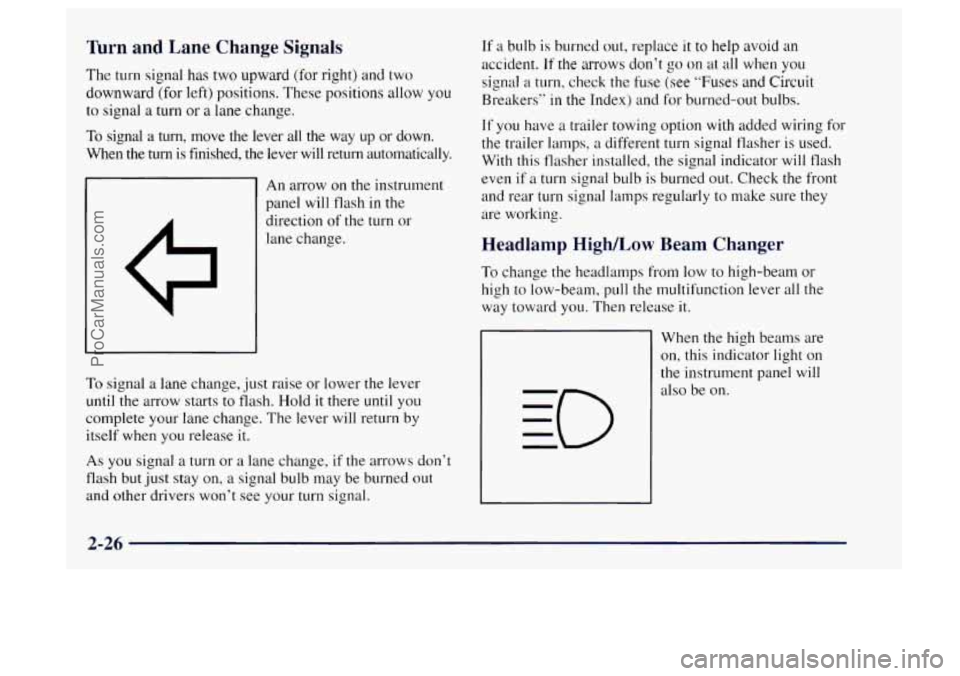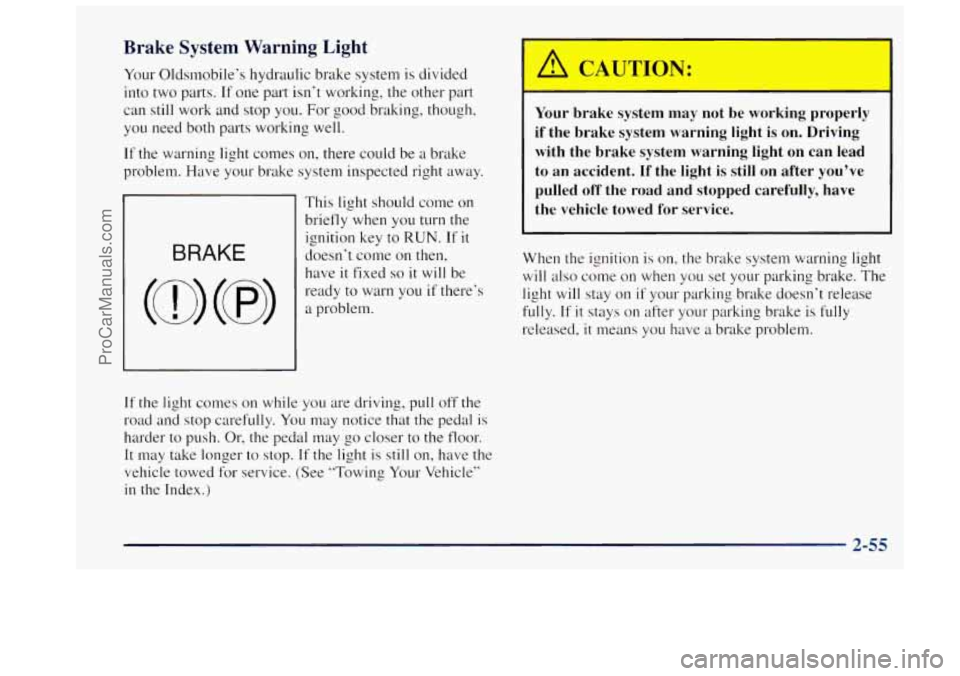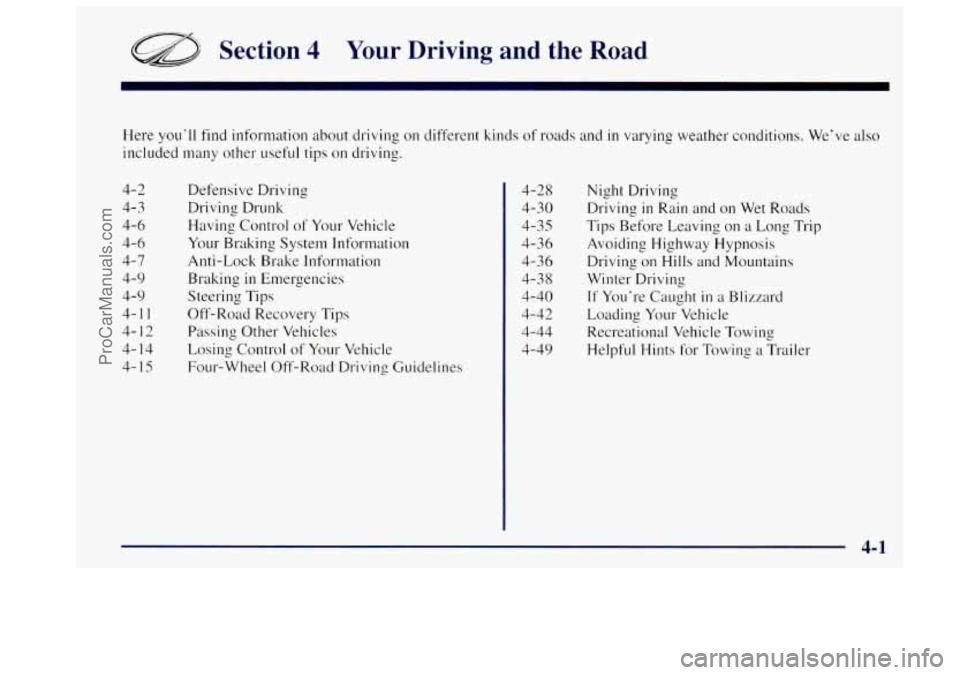tow OLDSMOBILE BRAVADA 1997 User Guide
[x] Cancel search | Manufacturer: OLDSMOBILE, Model Year: 1997, Model line: BRAVADA, Model: OLDSMOBILE BRAVADA 1997Pages: 358, PDF Size: 18.02 MB
Page 79 of 358

Tilt Wheel
You should adjust the
steering wheel before
you drive.
You can raise it to the highest level to give your legs
more room when you enter and exit the vehicle.
To tilt the wheel, hold the steering wheel and pull the
lever toward you. Move the steering wheel to a
comfortable level, then release the lever
to lock the
wheel in place.
Do not adjust the steering wheel while driving.
Turn SignaVMultifunction Lever
The lever on the left side of the steering column
includes your:
Turn Signal and Lane Change Indicator
Headlamp HighLow Beam Changer
Windshield Wipers
Windshield Washer
0 Cruise Control
2-25
ProCarManuals.com
Page 80 of 358

Turn and Lane Change Signals
The turn signal has two upward (for right) and two
downward (for left) positions. These positions allow
you
to signal a turn or a lane change.
To signal a turn, move the lever all the way up or down.
When the
turn is finished, the lever will return automatically.
An arrow on
the instrument
panel will flash in the
direction of the turn or
lane change.
To signal a lane change, just raise or lower the lever
until the arrow starts to flash. Hold it there
until you
complete your lane change. The lever will return by
itself when you release it.
As you signal a turn or a lane change, if the arrows don't
flash but just stay on,
a signal bulb may be burned out
and other drivers won't see your
turn signal. If
a bulb is burned out, replace it to help avoid an
accident. If the arrows don't go on at
all when you
signal
a turn, check the fuse (see "Fuses and Circuit
Breakers"
in the Index) and for burned-out bulbs.
If you have
a trailer towing option with added wiring for
the trailer lamps, a different turn signal flasher is used.
With this flasher installed, the signal indicator will flash
even if a turn signal bulb is burned out. Check the front
and rear turn signal lamps regularly to make sure they
are working.
Headlamp HighLow Beam Changer
To change the headlamps from low to high-beam or
high to low-beam,
pull the multifunction lever all the
way toward you. Then release
it.
When the high beams are
on, this indicator light on
the instrument panel will
also be on.
2-26
ProCarManuals.com
Page 88 of 358

Dome Lamps Mirrors
The rear dome lamp has a switch that lets you turn it on
from the rear
of the vehicle.
Press the side of the switch with the lamp symbol to turn
on the front and rear dome lamps. Pressing the other
side
of the switch will turn the cargo area dome lamp
off, even when the liftgate and doors are open.
The front dome lamp will come on whenever the doors
are open.
Inside Daymight Rearview Mirror
Press the tab under the mirror to reduce glare from
headlamps behind you.
Outside Manual Adjust Mirror
Adjust your outside mirrors so you can just see the side
of your vehicle.
You can fold them before entering a car wash. Pull the
mirrors in toward the vehicle. Push the mirrors back out
when finished.
2-34
ProCarManuals.com
Page 109 of 358

Brake System Warning Light
Your Oldsmobile’s hydraulic brake system is divided
into two parts.
If one part isn’t working, the other part
can still work and stop you. For good braking, though,
you need both parts working well.
If the warning light comes on, there could be a brake
problem. Have
your brake system inspected right away.
This light should come on
briefly when you
turn the
ignition key to
RUN. If it
doesn’t come on then,
have
it fixed so it will be
ready
to warn you if there’s
a problem.
A CAUTION:
-
Your brake system may not be working properly
if the brake system warning light is on. Driving
with the brake system warning light on can lead
to an accident. If the light
is still on after you’ve
pulled off the road and stopped carefully, have
the vehicle towed
for service.
When the ignition is on, the brake system warning light
will also come on when you set your parking brake. The
light
will stay on if your parking brake doesn’t release
fully.
If it stays on after your parking brake is fully
released, it means you have a brake problem.
If the light comes on
while you are driving, pull off the
road and stop carefully. You may notice that the pedal is
harder to push. Or, the pedal may go closer to the floor.
It may take longer to stop. If the light is still on, have the
vehicle towed for service. (See “Towing Your Vehicle”
in the Index.)
2-55
ProCarManuals.com
Page 112 of 358

If the Light Is Flashing
The following may prevent more serious damage to
your vehicle:
0 Reducing vehicle speed.
0 Avoiding hard accelerations.
0 Avoiding steep uphill grades.
0 If you are towing a trailer, reduce the amount of
cargo being hauled as soon as it is possible.
If the light stops flashing and remains on steady, see
“If
the Light Is On Steady” following.
If the light continues to flash, when it is safe to do so,
stop the vehicle. Find a safe place to park your vehicle.
Turn the key
off, wait at least 10 seconds and restart the
engine.
If the light remains on steady, see “If the Light
Is On Steady” following. If the light is still flashing,
follow the previous steps, and drive the vehicle to your
retailer or qualified service center for service.
If the Light Is On Steady
You may be able to correct the emission system
malfunction by considering the following:
Did you recently put fuel into your vehicle‘?
If so, reinstall the fuel cap, making sure to fully install
the cap.
The diagnostic system can determine if the fuel
cap has been left off or improperly installed. A loose or
missing fuel cap will allow fuel to evaporate into the
atmosphere.
A few driving trips with the cap properly
installed should turn the light off.
Did you just drive through a deep puddle of water?
If so, your electrical system may be wet. The condition
will usually be corrected when the electrical system
dries out.
A few driving trips should turn the light off.
2-58
ProCarManuals.com
Page 118 of 358

Comfort Controls Temperature Knob
With this system, you can control the heating, cooling
and ventilation
in your vehicle.
Climate Control System
Fan Control
The switch with the fan symbol changes the fan speed.
To increase the fan speed, move the switch upward
toward
HI. To decrease the fan speed, move the switch
downward toward
LO.
The upper knob regulates the temperature of the air
coming through the system. Turn the
knob clockwise for
warmer air. Turn the knob counterclockwise for cooler air.
Mode Knob
The lower knob allows you to choose the direction of
air delivery.
OFF: This setting turns the system off. Some outside air
will still enter the vehicle whenever the vehicle is
moving forward.
MAX A/C: This setting provides maximum cooling
with the least amount of work. MAX A/C recirculates
much of the air inside your vehicle
so it cools quickly.
A/C: This setting cools the air entering your vehicle and
directs
it through the instrument panel outlets.
+’ BI-LEVEL A/C: Air is delivered through the
heater
floor outlets as well as the instrument panel outlets.
/J VENT This setting directs airflow through the
instrument panel outlets. The air conditioning
compressor is not working when
VENT is selected.
+*
+e
3-2
ProCarManuals.com
Page 121 of 358

Defogging and Defrosting
On cool, humid, days use BLEND to keep the
windshield and side windows clear.
Use DEFROST to remove fog or ice from the
windshield quickly
in extreme humid or cold conditions.
Turn the temperature knob clockwise and move the fan
control toward
HI.
Rear Window Defogger
The rear window has lines that warm the glass. For best
results, clear the window of as much snow or ice as
possible before using the rear window defogger.
To turn on the rear window defogger, find the switch
marked REAR
DEFOG on your instrument panel below
the headlamp switch. Press
ON until the light in the
switch comes on, then release it.
It will only work if the
ignition switch is turned to
RUN.
The rear window defogger will stay on for five to seven
minutes, then turn off. If you need additional warming
time, turn it on again. You can turn the defogger
off at
any time by pressing OFF.
Do not attach a temporary vehicle license, tape or decals
across the defogger grid on the rear window.
NOTICE:
Don’t use a razor blade or something else sharp
on the inside
of the rear window. If you do, you
could cut
or damage the warming grid, and the
repairs wouldn’t be covered by your warranty.
3-5
ProCarManuals.com
Page 133 of 358

Section 4 Your Driving and the Road
Here you’ll find information about driving on different kinds of roads and in varying weather conditions. We’ve also
included many other useful tips on driving.
4- 2
4-3
4-6
4-6 4-7
4-9
4-9
4-1
1
4-12
4-14
4- 15
Defensive Driving
Driving Drunk
Having Control of Your Vehicle
Your Braking System Information
Anti-Lock Brake Information
Braking
in Emergencies
Steering Tips
Off-Road Recovery Tips
Passing Other Vehicles
Losing Control of Your Vehicle
Four-wheel Off-Road.Driving Guidelines Night
Driving
Driving
in Rain and on Wet Roads
Tips Before Leaving on a Long Trip
Avoiding Highway Hypnosis
Driving on
Hills and Mountains
Winter Driving
If You’re Caught in a Blizzard
Loading Your Vehicle
Recreational Vehicle Towing
Helpful Hints for Towing
a Trailer
4-28
4-30
4-35
4-36
4-36
4-3
8
4-40
4-42
4-44
4-49
4-1
ProCarManuals.com
Page 176 of 358

Payload
The payload capacity is shown on the Certificationrnire
label. This is the maximum load capacity that your
j vehicle can carry. Be sure to include the weight of the
1 occupants as part of your load. If you added any
accessories or equipment after your vehicle left the
factory, remember to subtract the weight of these things
from the payload. Your retailer can help you with this.
Add-on Equipment
When you carry removable items, you may need to put a
limit
on how many people you carry inside your vehicle.
Be sure to weigh your vehicle before you buy and install
the new equipment.
I
1 NOTICE:
I Your warranty doesn't cover parts or i
I
components that fail because of overloading.
Towing a Trailer
If you don't use the correct equipment and drive
properly, you can lose control when you pull
a
trailer. For example, if the trailer is too heavy, the
brakes may not work well
-- or even at all. You
and your passengers could be seriously injured.
Pull
a trailer only if you have followed all the
steps in this section.
Ask your Oldsmobile retailer
for advice and information about towing
a trailer
with your vehicle.
4-44
ProCarManuals.com
Page 177 of 358

I NOTICE:
Pulling a trailer improperly can damage your
vehicle and result in costly repairs not covered by
your warranty.
To pull a trailer correctly, follow
the advice in this part, and see your Oldsmobile
retailer for important information about towing
a trailer with
your vehicle.
Every Bravada is ready for some trailer towing. If yours
was built with trailering options, as many are, it’s ready
for heavier trailers. But trailering is different than just
driving
your vehicle by itself. Trailering means changes
in handling, durability and fuel economy. Successful,
safe trailering takes correct equipment, and
it has to be
used properly.
That’s the reason for this part.
In it are many
time-tested, important trailering tips and safety rules.
Many of these are important for your safety and that of
your passengers.
So please read this section carefully
before you pull
a trailer.
If You Do Decide To Pull A Trailer
If you do, here are some important points:
0
0
0
0
0
There are many different laws, including speed limit
restrictions, having to do with trailering. Make sure
your rig
will be legal, not only where you live but
also where you’ll be driving.
A good source for this
information can be state or provincial police.
Consider using a sway control
if your trailer will
weigh 2.000
Ibs. (900 kg) or less. You should always
use
a sway control if your trailer will weigh more
than 2,000 lbs. (900 kg). You can ask a hitch dealer
about sway controls.
Don’t tow a trailer at all during the first 500 miles
(800 kln) your new vehicle
is driven. Your engine,
axle or other parts could be damaged.
Then, during the first 500 miles (800
kin) that you
tow a trailer, don’t drive over SO mph (80 kdh) and
don‘t make starts at
full throttle. This helps your
engine and other parts of your vehicle wear
in at the
heavier loads.
You should use THIRD
(3) (or, as you need to, a
lower gear) when towing a trailer. Operating your
vehicle
in THIRD (3) when towing a trailer will
minimize heat buildup and extend the life of
your transmission.
4-45
ProCarManuals.com